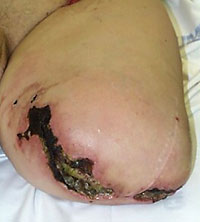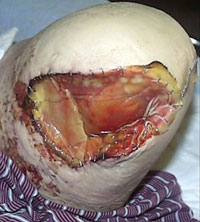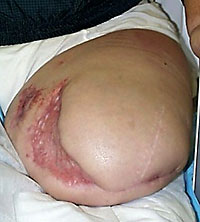
|
A 64-year-old man with unreconstructable
aortoiliac atherosclerosis developed toe ulcers.
The patient went through progressive levels of amputation,
each complicated by further necrosis. Necrosis of
the thigh amputation illustrates a prime dilemma
in operating on severely ischemic parts. Suturing
wounds and flaps creates tension which can diminish
circulation. In the presence of prior hypoperfusion,
the reduction is enough to kill tissue. However,
you also cannot reliably leave the wound open, because
highly ischemic tissues are intolerant of desiccation,
bioburden, inflammation and injurious topical medicaments.
This wound was sutured, and adjacent tissues died.
If it is now simply debrided and left open, it will
likely die some more. Most surgeons avoid this dilemma
by simply doing a higher level amputation, but in
this case, that option has run out.
|
 |


|
Integra solves this dilemma, allowing
one to debride the wound and then immediately close
it without stress or tension on the tissues. By
arresting inflammation, it controls yet another
factor which threatens the ischemic wound. Seen
here two weeks after debridement and Integra, the
wound is healthy, and there is no necrosis at any
of the margins. Because surgical revascularization
was not possible, hyperbaric oxygen was used as
an adjunct therapy for two weeks after Integra placement.
|
 |
|
The Integra and skin grafts healed
without problems, and the reconstruction remained
stable.
|
 |
Cases Courtesy of:
Marc E. Gottlieb, M.D., Jennifer Furman
Journal of Burns and Wounds, Vol 3, #2